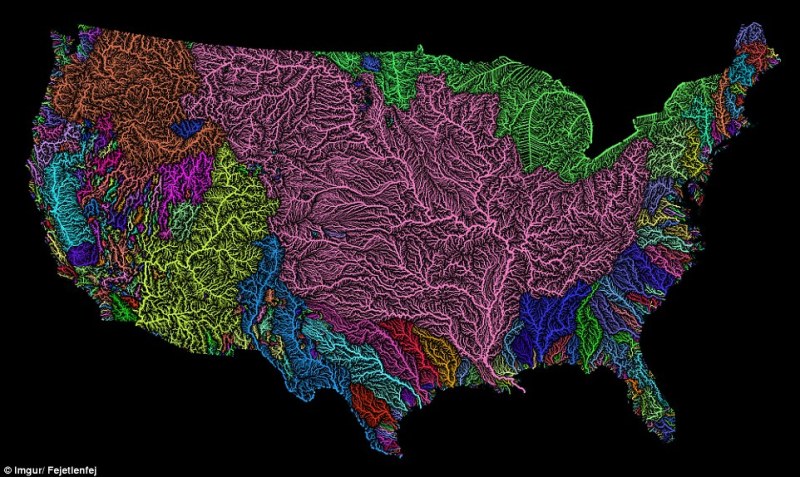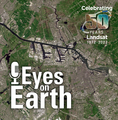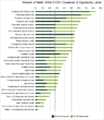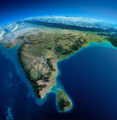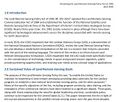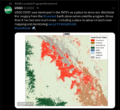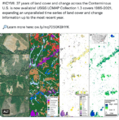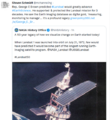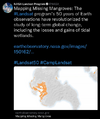Category:Watersheds: Difference between revisions
Siterunner (talk | contribs) No edit summary |
Siterunner (talk | contribs) No edit summary |
||
| Line 1: | Line 1: | ||
[[File:Featured.png]] | [[File:Featured.png]] | ||
| Line 18: | Line 18: | ||
[[File:Watershed monitoring earthscience m.png]] | [[File:Watershed monitoring earthscience m.png]] | ||
[[File:US River basins - watersheds.jpg]] | |||
Revision as of 19:54, 13 June 2024
We all live in a watershed. What's your watershed?
A drainage basin or catchment basin is an extent or an area of land where surface water from rain, melting snow, or ice converges to a single point at a lower elevation, usually the exit of the basin, where the waters join another waterbody, such as a river, lake, reservoir, estuary, wetland, sea, or ocean. For example, a tributary stream of a brook that joins a small river is tributary of a larger river, which is thus part of a series of successively smaller area but higher elevation drainage basins. Similarly, the Missouri and Ohio rivers are each part of their own drainage basins and that of the Mississippi River.
Other terms that are used to describe drainage basins are catchment, catchment area, drainage area, river basin and water basin. In North America, the term watershed is commonly used to mean a drainage basin, though in other English-speaking countries, it is used only in its original sense, to mean a drainage divide, the former meaning an area, the latter the high elevation perimeter of that area. Drainage basins drain into other drainage basins in a hierarchical pattern, with smaller sub-drainage basins combining into larger drainage basins...
Pages in category "Watersheds"
The following 7 pages are in this category, out of 7 total.
Media in category "Watersheds"
The following 35 files are in this category, out of 35 total.
- AB 2480 Meadows and Forest Water Infrastructure.png 481 × 375; 248 KB
- About Baselines and Change.png 592 × 312; 33 KB
- Bill Mollison 1928-2016.pdf ; 99 KB
- Bill Mollison courtesy of Permaculture magazine.jpg 460 × 300; 0 bytes
- Bill Mollison the day after his passing memories.png 1,381 × 651; 1.65 MB
- California's kelp forests and coastal biodiversity diminished.png 532 × 754; 307 KB
- Celebrating 50 Years of Landsat.png 600 × 610; 909 KB
- Florida via NASA 2022.png 800 × 1,020; 1.12 MB
- Florida Wildlife Corridor - 2022 illustration.png 800 × 628; 473 KB
- Florida Wildlife Corridor FLWC Water Benefits December 2022.png 768 × 886; 109 KB
- Hindu Kush-Himalayas - 2023 Report on Dangerous Climate Impacts.png 800 × 819; 1,023 KB
- Land Remote Sensing Policy Act of 1992.jpg 563 × 480; 144 KB
- Landsat band imagery2.png 800 × 400; 907 KB
- Landsat data site.png 657 × 600; 499 KB
- Landsat launched 50 years ago today.png 528 × 779; 755 KB
- Landsat NASA - Feb 11 2023.png 763 × 600; 578 KB
- Landsat US collection of maps 1985-2021.png 768 × 775; 1,018 KB
- Landsat, a 50 year legacy.png 528 × 575; 288 KB
- Mangroves and Coastal Wetlands tracked by Landsat.png 600 × 716; 245 KB
- OaklandWastewater plant.jpg 800 × 399; 125 KB
- Permaculture-observation tip.jpg 480 × 540; 86 KB
- Rain Garden Design courtesy of www.PermaDesign.com Nate Downey.png 800 × 614; 601 KB
- River basins - watersheds.jpg 800 × 214; 111 KB
- Secret Life of Rivers.png 800 × 451; 800 KB
- Shifting Baseline Syndrome - threats to ecosystems biodiversity.png 431 × 534; 322 KB
- Shifting Baselines 2.jpg 600 × 600; 140 KB
- Toby Hemenway-RIP Dec2016.png 503 × 327; 32 KB
- US River basins - watersheds.jpg 800 × 477; 131 KB
- Water Action News - March 2023.png 640 × 277; 103 KB
- WaterAction - 2023.PNG 480 × 640; 300 KB
- Watershed monitoring earthscience l.png 1,430 × 900; 462 KB
- Watershed monitoring earthscience m.png 572 × 360; 143 KB
- Wetlands - Wetlands Day.png 640 × 492; 333 KB


